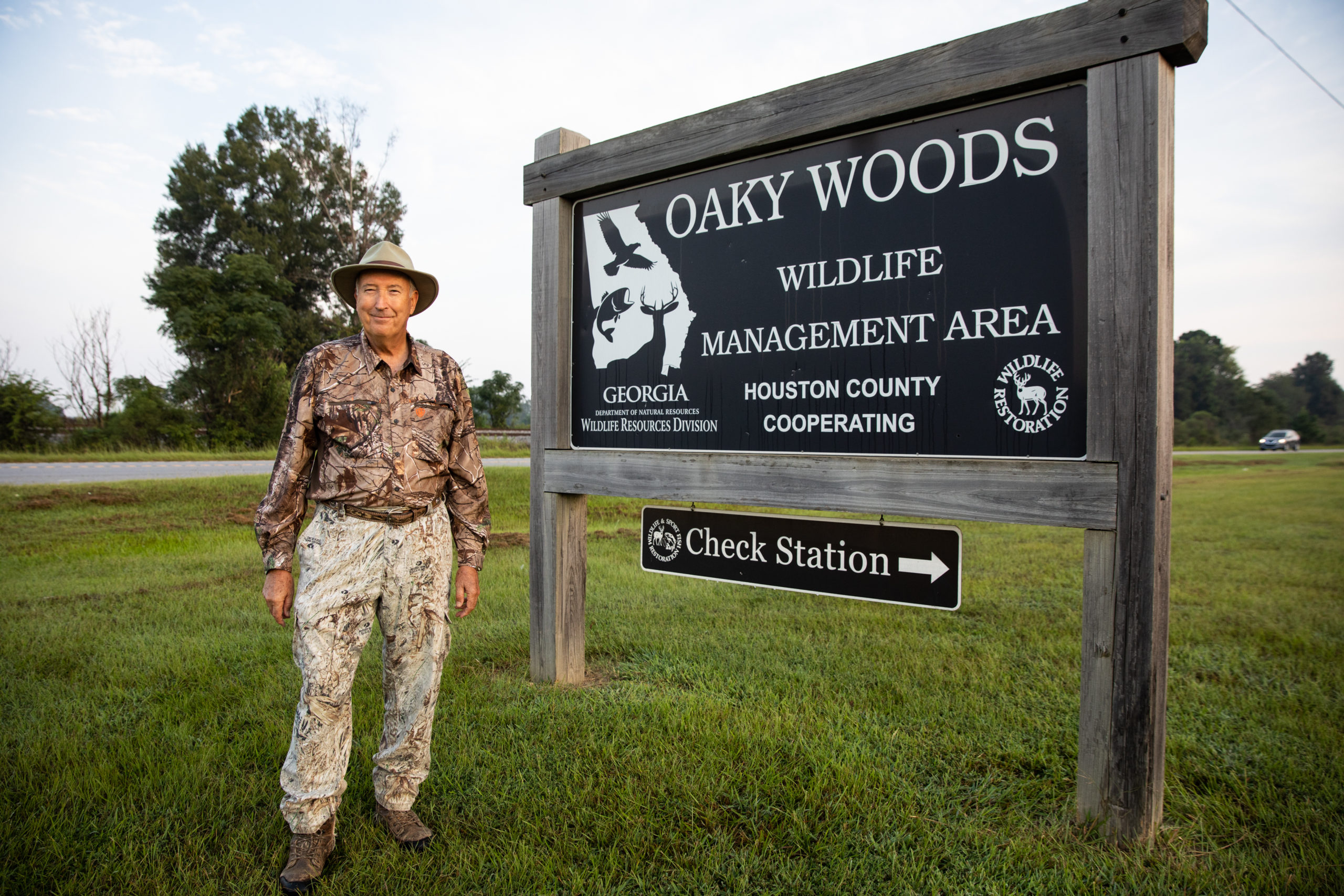
‘It might have to be me’
Outdoorsman John Trussell chronicles his work to preserve Oaky Woods
By Michael W. Pannell
Photography by Christopher Smith
Oaky Woods, one of Georgia’s 135 Wildlife Management Areas, is located in the southeast portion of Houston County along the Ocmulgee River and has long been a favorite spot of sportsmen and lovers of wild spaces.
The Department of Natural Resources says Oaky Woods is 12,750-acres offering opportunities for hunting deer, turkey, small game, coyote and feral hog — but there’s more.
On the DNR’s Oaky Woods web page, it goes on to say the site also offers primitive campsites, geocaching, fishing, organized quota and youth hunts and wildlife viewing.
What it doesn’t mention is hikers, cyclists and enthusiasts of numerous other outdoor activities are welcome.
“It is beautiful, and you can see all kinds of wildlife,” said Warner Robins bicyclist Rebekah Less. “Honestly, you can get a lot of miles on the bike there, too. It’s a great place to ride with a group of people of all levels and see beautiful scenery, wildlife and make the experience what you want.”
Another thing the DNR site doesn’t mention is that Oaky Woods is part of one of Georgia’s three primary black bear population areas and, like the black bears there, was itself once threatened by Houston County’s explosive growth — nearly 100,000 new people in the past 50 years and an average increase of more than 2,300 people per year for most of the last five years.
Apart from circumstance, local conservation advocacy, county involvement and eventual state action, enjoyment of the now protected public lands would be lost and with it the habitat of 300-400 black bears, other wildlife, plants and trees — some rare.
The woods could easily have become just another neighborhood with as many as 30,000 residential lots.
The story of Oaky Woods and how it came to be safeguarded would take a book to detail, and there is such. It was written by John Trussell, a retired head of Houston County’s probation office, historian, outdoor writer and the central figure in the quest to save Oaky Woods.
By late last century, that phrase, “Save Oaky Woods,” became a battle cry and bumper sticker. It’s also the name of Trussell’s book detailing facts about the woods and the long effort to save it. It also shows what a handful of dedicated conservationists and outdoorsmen can accomplish.
“I first set foot in Oaky Woods when I was 15 and loved it ever since,” Trussell said. “I’ve hunted, hiked, ridden my bike and enjoyed Oaky Woods in so many ways I just couldn’t imagine us losing. But I could easily see it happening. I thought someone should do something about it and realized it might have to be me.”
Trussell, now 70, said his family moved to Houston County from Butler County when he was 2 years old. He developed an early love for the outdoors as a youngster roaming around, and knew the location of every beaver pond between Sandy Run Drive and Leisure Lake.
By 12 he’d built his own log cabin.
But before going further, knowing Oaky Woods’ broader history is warranted.
What’s now Oaky Woods was a favorite homeland to Native Americans who left artifacts dating back at least 13,000 years. All farmed, fished, hunted and practiced commerce in communities along the Ocmulgee’s banks and traveled up and down the river for trade and socialization — including visiting neighbors to the north at what is now Ocmulgee Mounds National Historical Park.
It was a Clovis point — think spear tip or arrowhead — found in the area that dated back to prehistoric, Paleo-Americans showing that where cyclists now ride and hunters pursue turkeys, ice-age hunters may have hunted or defended themselves against large game including wooly mammoths.
More modern Native Americans, such as the Muscogee (Creek), lived there before being driven west from Georgia when lands were illegally taken and they were relocated to Oklahoma, where many live today.
“The history is so rich and the area so beautiful that I and others believed it would be a tragedy to let it go,” Trussell said. “Not to mention the impact of losing such an important bear habitat. As a private citizen, I got involved because I believe anyone can have a positive impact and everyone should leave things better than they were — certainly not worse.”
Trussell writes in his book that in 1966, 19,000 acres of Oaky Woods was leased by the state. For years, the larger Oaky Woods area was privately owned by timber, land and forest products companies, most notably Weyerhaeuser Co., which sold all its Georgia land holdings in 2004.
As an outdoor columnist for Warner Robins’ one-time daily newspaper, The Sun, Trussell advocated as early as 1986 that the state should get a firmer hold on the property as protected public lands.
But Oaky Woods was purchased by a development group for new neighborhoods. Work to save the site began in greater earnest and by 2006, the cry, “Save Oaky Woods,” was heard more and more from conservationists and sportsmen. The economic downturn in 2007 played a hand in forestalling development and brought Oaky Woods back to the market and susceptible to development.
Briefly outlining a complex tale, Trussell said through the years the effort became “a political football,” with the state passing on and eventually deciding to buy portions of the woods. There still are strong opinions as to how well the “political football” game was played, but to Trussell and others, the fact is Oaky Wood’s was indeed saved.
By late 2010, just as former Gov. Sonny Perdue, a Houston County native, was leaving office, the state paid almost $29 million for 9,500 acres of Oaky Woods to come under DNR control for protection and use by citizens.
As a WMF, the state requires a sporting or land pass license to use the woods, but Trussell said a $15 hunting or fishing license does the job inexpensively and is well worth it. Plus, he said it helps keep natural sites operating.
In addition to what was bought by the state, acreage owned by Houston County around its landfill — Oaky Woods’ southern neighbor — was leased to the state, bringing the woods to its now protected 12,750 acres.
“I’m very pleased the state chose to purchase Oaky Woods and invest in preserving it for the future and use by those who love hunting and fishing and many types of outdoor activities,” said Tommy Stalnaker, chairman of the Houston County Board of Commissioners. “John Trussell is an outdoorsman if I’ve ever seen one, and keeping the woods natural and available was a goal of his for many, many years.”
Trussell is obviously pleased.
“Today, you can hunt, fish, walk around, ride your bike, observe nature, camp and enjoy all that Oaky Woods offers,” Trussell said. “The birds, the wildlife and the black bears and their cubs have a secure habitat. I believe the public’s quality of life is improved by experiencing the outdoors and all that Oaky Woods teaches us. The DNR and I both encourage people to get outdoors and do more. We need to be more in touch with the natural process of things.”
For years, Bill Bethune hunted small game in Oaky Woods.
“There was a time I was in Oaky Woods every Saturday hunting rabbits with beagles,” he said. “With the population growth now, the state’s extended deer season and people buying up so much land for private deer hunting clubs, it’s getting difficult to find good places to hunt small game apart from having public lands. Thank goodness Georgia has land like Oaky Woods; we’re fortunate. In the long haul, there’s no question it was a good purchase. It’s a win-win with such a diversity of game and just to have it to get out and walk around on, to relieve some stress.”
Georgia’s hunting and fishing seasons are observed at Oaky Woods but it is a year-long bear sanctuary — no exceptions. State one-day bear hunts never include Oaky Woods or the neighboring Ocmulgee WMA, just over in Twiggs County.
How do hunters, hikers and others co-exist in the woods? Or, for that matter, people and black bears?
“By using common sense and hunter safety,” Trussell said. “There hasn’t been an incident though common sense may tell hikers that early morning hikes in peak hunting seasons may not be the best time.
“As far as black bears, there’s never been a bear attack in Georgia. There are sightings, yes, but unlike some other bears, black bears are shy and won’t go out of their way to harm people. They go out of their way to avoid people. Of course, don’t try to feed them or bother them — especially with their cubs. Don’t do anything ridiculous like that. Really, it’s rare to see one. They head the other way.”
Trussell often speaks to groups about Oaky Woods and remains involved. Besides “Saving Oaky Woods,” he continues writing books on the outdoors, history and is an avid cyclist who was selected to write about Georgia in the Falcon Guide’s series on bicycling routes. The book is called “Road Biking in Georgia: A Guide to the Greatest Bicycle Rides in Georgia” and like his other works, it’s available on Amazon.
Trussell also frequently contributes to the popular Georgia Outdoor News’ website at gon.com.
Until COVID-19 interrupted, Trussell led regular Oaky Woods walking tours and hopes to continue them in early 2022. Walks include wandering the many dirt roads and trails, taking note of wildlife and evidence of wildlife and exploring things like the remains of a one-time moonshine still.
Then there’s the historical oddity of Oaky Woods’ no-longer-used fire tower.
“It’s interesting to see but unfortunately it’s been vandalized, fallen into disrepair and not safe for the public to climb,” he said. “That’s a shame. I’d love to see it restored.”
Learn more
saveoakywoods.com
georgiawildlife.com/oaky-woods-wma.







